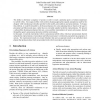55 search results - page 11 / 11 » Autonomous learning of 3D reaching in a humanoid robot |
AAMAS
2005
Springer
13 years 10 months ago
2005
Springer
The ability to determine a sequence of actions in order to reach a particular goal is of utmost importance to mobile robots. One major problem with symbolic planning approaches re...
ICRA
1999
IEEE
13 years 9 months ago
1999
IEEE
We consider the robot exploration of a planar graphlike world. The robot's goal is to build a complete map of its environment. The environment is modeled as an arbitrary undi...
ECAL
1995
Springer
13 years 8 months ago
1995
Springer
Neither `design' nor `evolutionary' approaches to building behavior-based robots feature a role for development in the genesis of behavioral organization. However, the n...
FIRSTMONDAY
2010
13 years 2 months ago
2010
In recent years, new socially-oriented Web technologies have been portrayed as placing the learner at the centre of networks of knowledge and expertise, potentially leading to new...
JIRS
2000
13 years 4 months ago
2000
Agents (hardware or software) that act autonomously in an environment have to be able to integrate three basic behaviors: planning, execution, and learning. This integration is man...

